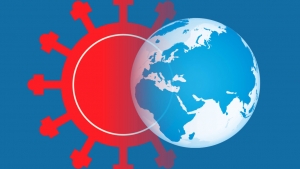عرض العناصر حسب علامة : اليوتيوب
الخميس, 16 سبتمبر 2021 10:16
تسويق شركتك: الاستراتيجية الرقمية حتمية
غيّر عام 2020 كل شيء عن كيفية عمل الشركات، بما في ذلك كيفية تفاعلها مع الجميع من الموظفين إلى العملاء ومن البائعين إلى المجتمعات
معلومات إضافية
-
المحتوى بالإنجليزية
Marketing your firm: The digital strategy imperative
By David M. Toth
May 12, 2021, 9:00 a.m. EDT
5 Min Read
Facebook
Twitter
LinkedIn
Email
Show more sharing options
2020 changed everything about how businesses operate, including how they interact with everyone from staff to clients, vendors to communities. The COVID-19 pandemic resulted in a digital transformation that changed the way people purchase consumer products, goods, and services. Until 2020, only 15% of companies prioritized digital transformation. In 2021 however, 77.3% of CIOs rated digital transformation as a top priority, pushing cybersecurity to second place.
Firm leaders of today and tomorrow looking to succeed in an increasingly virtual market must lean into the momentum that has been created since the beginning of the pandemic, take those learning experiences and data points, and uncover new paths to revenue growth.
Digital presence is nothing new and has lived as a function of marketing for a long time. But as client acquisition becomes more complex and anomalies like those of the Paycheck Protection Program and CARES Act have proved to firms that opportunities do exist through virtual experiences, a sound digital strategy must find its place as a pillar of your firm’s 10-year vision.
Empower your firm with the Intuit ecosystem of tax and accounting products
Expand your tax software with tools that help you work better, faster, end-to-end. Intuit offers a full support system, developed by and for tax...
SPONSOR CONTENT FROM INTUIT
The ability to remain competitive in 2021 and beyond is now dependent upon an approach that engages your target audience in tailored and unique ways, either pushing them through a thoughtfully designed qualification process or grooming unqualified leads to become clients of the future. Key tools to a successful plan include:
The evolution of your website into a sales tool;
Leveraging content to answer your audience’s pain points and challenges;
Thought leadership to establish expertise and positioning in key channels;
Comprehension of the “new” client journey;
A tactical approach to keyword strategy and search engine rankings;
Leveraging email marketing that has been a proven tactic in our toolbox for 20-plus years;
Defining the conversion funnel for your firm as it relates to managing each touchpoint;
Identifying digital champions inside your firm; and,
Technology adoption across marketing and sales.
As digital strategy evolves to become an immediate and impactful portion of the client experience, the prospect-to-client journey you create (read: your digital strategy) will require the same level of attention in a virtual environment as it would in-person. The above tools combine to provide rich insight into each visitor’s online movements, interests, and interactions, allowing your firm to curate a personalized, guided experience from the moment they walk in your virtual “front door.”
In fact, prospects and clients already expect and demand a frictionless journey, shifting the traditional focus of business development from relationships in the market to virtual experiences online. Providing a frictionless experience to your prospects and clients requires your firm be able to capture data, automate their interactions, and gain insight from the time they get to your website to the time they interact with your colleagues in the local community. The ability to centralize this information into one dashboard removes the hurdles and unnecessary complexity from a rapidly evolving process.
New opportunities
Geographic boundaries have vanished, but new boundaries related to the virtual buyer’s journey and the pandemic have sprung up between firms and prospective clients. This shift has created a digital strategy imperative. Every facet of the prospect-to-client relationship is now critical to maintaining a data-driven approach to measure what must be managed.
And there are big opportunities to be had. Implementation of a digital rainmaker strategy grants firms the ability to establish meaningful relationships while building a book of business that extends beyond any one individual. Opportunities generated through a broad, sophisticated digital strategy will create an output of higher conversion rates (and more time dedicated to clients and billable hours) for partners, ultimately yielding increased cash flow and profitability for the firm.
So, what are the foundations of a sound digital rainmaker strategy?
1. Data is king. So is content. You may have seen some headlines recently about the way data is going to be collected and stored by internet giants like Google, Facebook, YouTube and Amazon. Their methods are evolving rapidly to put the user first and protect their data. What does that mean for your digital strategy? Data collection will be much more critical at the firm level versus relying on third-party sources. Attention will become a commodity and competition for users’ time on the internet will be more challenging. Strong, relatable content that shows thought leadership will pave the path to establishing an authoritative voice and a strong following.
2. Focus on one vertical at a time. Developing a source of qualified leads through digital marketing of specific verticals and practice lines is the best way to create success stories for repeatable growth. Trying to tackle and embrace the entire firm's transition to one of digital culture will have its challenges. Embracing a model that is generating traceable, repeatable, and sustained revenue comes with focus, leadership, and the ability to identify digital champions within the firm. Who will be the next partner to champion video, thought leadership creation, and a podcast with 40,000 monthly subscribers?
3. Data flow drives decisions. Visibility and accountability at all levels is critical and data flow, analytics, and dashboards connecting the path from marketing inception to sales conversion provide the insight needed to know what’s working and what isn’t. Data-driven growth is integral to the future-ready firm.
4. Adoption at all levels is critical. Why do only 30% of digital transformations succeed? Because, according to McKinsey, adoption must be endemic — and that’s a hard nut to crack. Adoption that starts at the top level and becomes part of the firm's strategic plan, goals, metrics, and key performance indicators at all levels is more likely to succeed and produce the greatest return on investment.
As client acquisition becomes ever more challenging and complex, as client experiences trend toward virtual and away from in-person exclusively, and as the prospect-to-client expectations continue to evolve, this imperative will become ever more critical to your success.
نشر في
موضوعات متنوعة
موسومة تحت
الأربعاء, 15 سبتمبر 2021 09:03
كيفية الارتقاء بتجربة العملاء في عالم ما بعد كورونا؟
بالنسبة للشركات الاستهلاكية التي تجد نفسها في الوضع الطبيعي التالي، حان الوقت الآن لإعادة تصور ما يعنيه الوضع الطبيعي الجديد.
معلومات إضافية
-
المحتوى بالإنجليزية
How to elevate customer experience in a post COVID-19 world
By Sukesh Choubey
EY Global Delivery Services SAP, Microsoft and Supply Chain Leader
6 minute read
15 Feb 2021
Related topics
Consumer products and retail Supply chain E-commerce
Upvote 10
For consumer businesses finding themselves in the next normal, now is the time to reimagine what the new normal means.
Three questions to ask
How has COVID-19 shaped consumer behavior?
How can CPG companies gain a competitive advantage by embracing this new reality and adopting emerging trends?
How will frictionless shopping solutions help CPG companies gain competitive advantage?
How EY can help
Customer experience
When it comes to serving the customer of the future, the answers lie in being client-centric, especially in today’s world.
Read more
Related article
How digital transformation opened new channels for growth
How digital transformation opened new channels for growth
With help from EY professionals, Royal Caribbean’s digital-first approach is trans…
26 Mar 2021 EY Global
We are all living in unprecedented times and the pandemic has radically impacted our everyday life. Each one of us has seen the impact the COVID-19 pandemic has had on the consumer psyche and businesses alike. During the lockdown, consumers stockpiled essential goods such as groceries, dry foods, and other household products, in wake of the impending crisis. This spike in demand for essentials disrupted the supply chains for most of the Fast-Moving Consumer Goods (FMCG) companies. On the other hand, non-essential (good-to-have-goods) product companies, such as apparel and luxury products, witnessed a sharp decline in sales. Other factors familiar to many included restricted travel, remote working and growing economic concerns.
Some of these changes in customer behavior seem to be an irreversible trend, forcing consumer goods companies, more than others, to realign themselves to the new normal. Consumer Products and Goods (CPG) companies can gain a competitive advantage by embracing this new reality and adopting emerging trends would help consumer businesses thrive in the new normal.
1. eCommerce acceleration
Online presence is no longer optional for CPG companies. Many small and medium companies did not invest in eCommerce until recently. With consumer shift to online channels, since the COVID-19 pandemic began, there has been a growing demand for eCommerce platforms. Leading grocery retailers prefer to reduce online friction by simplifying the buying experience for essentials with the use of apps. Curbside pickup has proved to be one of the most conducive frictionless solutions for both retailers and customers. A leading sports retailer converted some of its stores into fulfilment centers to manage online orders. Food and beverage players identified the shift in consumer behavior and launched online D2C channels during this period. In addition, there was growing disintermediation using B2B eCommerce portals by CPG companies for their sales representatives, especially during the pandemic.
Business buyers seek simple, flexible, on-demand ordering experiences – a process that works best for them, at the time they desire. Back in 2015, Forrester found that nearly 75% of B2B buyers said that buying from a website was more convenient and efficient than buying from a sales representative.1 It would seem very likely that, were the same research conducted in 2021, the percentage would be even higher. In the future, digital adoption is expected to grow further and would be a key driver for growth for many consumer businesses.
2. Digital In-store experience
With a growing affinity for online shopping, CPG companies need to reinvent the in-store experience to reduce friction and ensure customers see value in coming back to stores. Digital engagement has accelerated tremendously, and leading companies have innovated quickly to replace traditional, in-store experiences. As the economy has begun opening, physical stores have seen a slight uptick in consumer traffic. This indicates that physical outlets will have to test modified in-store layouts to prevent customers from being in crowded situations and enable contactless shopping solutions to address health concerns.
Leading retail chains have been testing store traffic control using advanced queue management techniques, one-path shopping designs, and queueless buying options for popular products. Frictionless solutions (e.g., scan-and-go, click-and-collect, drive-through checkouts), buying/try-out kiosks are also some formats that are being used to reduce physical touchpoints for customers. Athletic footwear (A&F) players have seen store shutdowns but have also benefited from continued technology investments. Some A&F organizations have ramped up content marketing and adjusted subscription prices for digital fitness programs. It’s likely stores will become more conceptual and experiential, with customers being engaged in a better way through digital athlete training regimes.
There is also a growing preference for AI store assistants to supplement the customer experience with product information and recommendations. AI can also answer questions as well as take orders for customized products that have a different color, stitching, size or accessories. Now is the time for consumer companies to invest in the data, technology and systems required to deliver exceptional consumer experiences. Organizations that can understand customers better and adapt faster are likely to be the next customer-experience leaders.
Consumer companies must invest in the data, technology and systems required so they are able to deliver the kinds of exceptional consumer experiences that will give them a competitive edge and position them as the next customer-experience leaders.
How EY can help
Customer engagement
In today’s world of empowered customers, competitive advantage shifts from being purely competing over product and price to building trust. To prosper, you need to consider a customer-centric marketing model built on unwavering trust and loyalty.
Read more
3. Dynamic and agile supply chain planning
During the lockdown, inventory management became a problem as people started stockpiling and manufacturing went on freeze temporarily. A spike in online sales, abrupt consumption patterns, disrupted supplies and unpredictable future have made organizations realize that what worked till now, will not work in the future. How can companies accurately forecast demand and capture the impact of situations such as a pandemic? An effective way would be greater collaboration for demand sensing between retailers and manufacturers, especially for anomalies. Furthermore, automation of sales operations and creating a digital environment to manage their entire supply chain is critical if companies need to build sales resilience.
4. Innovation in customer connect
While people continue to remain socially distant, bringing offline experiences online will ensure they continue to connect with the brands they identify with. Even though digital marketing has been a focus for CPG companies, greater impetus must be placed on leveraging new age communication channels to create deeper engagement with consumers. Some social media platforms have already enabled CPG companies to gain higher traction by personalizing communication compared to traditional marketing channels.
Additionally, influencer marketing, YouTube channels, blogs, etc., are all being used to create excitement around brands, new launches, etc., and drive the end-users toward purchase. Companies are constantly innovating new ways of connecting with consumers. Adopting technologies, including Augmented Reality (AR) and Virtual Reality (VR), will completely change the way brands communicate, launch new products and engage with consumers, all while ensuring the safety of consumers is not compromised.
As social distancing continues to be the norm, bringing offline experiences online will ensure continued customer engagement with an organization’s brand. The next step, however, must now be a bigger focus on leveraging new age communication channels with the aim of creating deeper consumer engagement.
To remain relevant and adapt to changing consumer behaviors, CPG companies must adopt agile operating models to lead in this dynamic environment. Digital is becoming an integral part of the customer’s purchase journey. Organizations need to analyze consumer consumption data in existing digital channels, modify assortments, build a robust network, and simplify and optimize UI/UX to enable a better customer buying experience. Physical stores should allow frictionless shopping, redesign store layouts, streamline store operations and reevaluate store networks to increase consumer confidence in physical channels. This must be supported by flexible delivery models and robust supply networks (fungible stores and warehouses).
A superior personalized experience can be achieved by enabling a seamless purchase journey for the consumer with close collaboration between physical and digital channels and being innovative in building omnichannel capabilities. In the long run, achieving these objectives will future-proof organizations and help them retain their competitiveness.
Show article references
Summary
The COVID-19 pandemic has created what many expect to be irreversible trends in customer behaviors. But there is a competitive advantage to be gained by CPG companies that embrace this new reality and adopt emerging trends, such as agile supply chain planning and innovative ways to connect with customers.
نشر في
موضوعات متنوعة
الأربعاء, 28 سبتمبر 2022 12:03
قمة الإتحاد الدولي للمحاسبين IFAC: الاتجاهات العالمية التي تحول التعلم والتطوير
معلومات إضافية
-
المحتوى بالإنجليزية
Building on the Education Summit’s Success to Transform Learning and Development
GABRIELLA KUSZ MBA, MPP, CPA, CGMA | JANUARY 20, 2021
IFAC accountancy education summit, The Anticipatory Accountant: Global Trends Transforming Learning and Development, was a great success—reaching over 1,600 accountancy professionals in business, government, and academia. The Summit’s message, guided by world-renowned futurist Daniel Burrus and expanded upon by Business Learning Institute CEO Tom Hood, was one of shifting the future view of the accountancy profession from reacting to reflecting on key trends and anticipating how best to position the industry for future success.
The summit explored important key trends in TECHNOLOGY, ENVIRONMENT, and SOCIETY, in addition to providing a platform for stimulating anticipatory thinking and re-imagining the nature of the profession and learning and development. While we can’t see exactly what the future of the accountancy profession may hold, the summit helped IFAC and professionals around the world identify key global trends, understand their influence on the next decade, and enhance their ability to transition ahead of time.
Using these key insights, the accountancy profession can move away from the constant and exhausting cycle of reacting to anticipating the future and gently evolving to ensure the longer-term relevance and value of our industry, planet and people.
The Anticipatory Accountant summit is not an end in and of itself. Rather, it is a starting point for multiple working groups that will examine the key themes, discussions and outcomes of the summit to shape forthcoming learning and development thinking, guidance and resources for our profession.
A recording of the entire summit is available on IFAC’s YouTube channel.
Don’t have time to watch the full-length version of the event? Watch the event in easy to access ~5-minute video shorts!
نشر في
محاسبة و مراجعة
الأربعاء, 18 نوفمبر 2020 13:09
مقتطفات رئيسية من سلسلة المجلس الدولي لمعايير المراجعة والتأكيد IAASB حول الاحتيال والاستمرارية
استضاف المجلس الدولي لمعايير المراجعة والتأكيد IAASB مؤخرًا ثلاث موائد مستديرة افتراضية مع خبراء وقادة لاستكشاف القضايا والتحديات المتعلقة بالاحتيال والاستمرارية
نشر في
محاسبة و مراجعة
موسومة تحت
الثلاثاء, 27 سبتمبر 2022 14:18
تحديث المعايير الدولية لإعداد التقارير المالية (IFRS) للشركات الصغيرة والمتوسطة لشهر سبتمبر 2020
تحديث المعايير الدولية لإعداد التقارير المالية للمنشآت الصغيرة والمتوسطة هو ملخص فريق العمل للأخبار والأحداث والمعلومات الأخرى حول المعايير الدولية لإعداد التقارير المالية للمؤسسات الصغيرة والمتوسطة
نشر في
محاسبة و مراجعة
الأربعاء, 12 أغسطس 2020 14:37
لماذا يمكن أن تكون شركات المحاسبة الأصغر هي خطوتك المهنية التالية؟
نشر في
محاسبة و مراجعة
موسومة تحت
الخميس, 11 يونيو 2020 13:07
كيف يمكن للمحاسبين تحقيق النمو عبر وسائل التواصل الاجتماعي؟!
نظرًا لأن معظم العالم يعزل نفسه الان، فقد زودت وسائل التواصل الاجتماعي المستهلكين بالاتصال خارج محيطهم المباشر، مما ساعد في الحفاظ على العلاقات عبر الإنترنت.
نشر في
تكنولوجيا المعلومات
الإثنين, 23 مايو 2022 13:59
إنفوجرافيك.. ما يمكنك القيام به كمحاسب قانوني الآن لمساعدة طلاب المحاسبة
نشر في
إنفوجرافيك
الخميس, 26 مارس 2020 10:15
ما يمكنك القيام به كمحاسب قانوني الآن لمساعدة طلاب المحاسبة
نشر في
تكنولوجيا المعلومات









